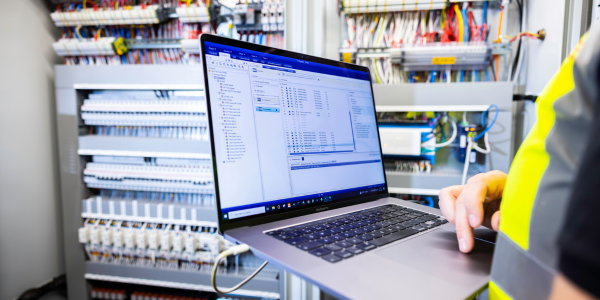To keep their business running, companies frequently use a complex mix of add-ons and packages that sit alongside a Building Management System (BMS), many of which don’t interact in an intuitive way with the building’s BMS. This is hardly surprising because technology has advanced tremendously in recent years and has outstripped typical BMS installations. Yet, many building owners continue to invest time, energy and resources into these disparate systems instead of creating a harmonious building solution.
The cost of maintaining and operating legacy systems has been estimated to account for as much as 60-80% of a company’s IT expenditure. These systems become harder to maintain as users move on or retire, leaving those new to the business with a collection of outdated tools, some of which have since shifted to the cloud – the ensuing mismatch becomes a digital transformation roadblock.
When it comes to migrating a legacy building management system, or installing a bespoke BMS from scratch, many UK building owners and managers are missing a fantastic opportunity.
Not All BMS Systems Are Created Equal
Automation of a BMS (Building Management System) is assumed to result in enhanced performance – after all, that’s what makes your building a Smart Building, right?
While a correctly designed BMS will make your building more efficient, resulting in a healthier atmosphere and, as a result, a more productive workforce, it’s not a one-size-fits-all solution. The suitability of the design and the ongoing maintenance of its programming are critical to your BMS’s performance.
When it comes to these systems, the technology is only as good as the person who designs, installs and maintains it. This is why a bespoke BMS system far outweighs a standard BMS in terms of efficiency, as it is tailored specifically to your building.
Upgrading your Building Management System
According to a survey conducted by the Department of Energy in the United States, an improperly configured BMS can waste up to 20% of a building’s energy. And, with rising energy costs, this is more an important consideration than ever before. With so many outdated and poorly configured BMS systems in the UK, it’s time to ask whether yours could benefit from an upgrade.
The first consideration in determining whether to upgrade or replace your system is to discern whether or not your outdated Building Management System is actually a problem. While the advances in technology and new array of features may be tempting, the reality could well be that your BMS is still performing perfectly for your team’s needs.
That being said, as your BMS ages, some genuine issues may arise. You may notice its performance deteriorating and not performing as expected by the users. Whether in terms of heating, cooling, or the amount of automation anticipated, this may prompt you to call in the experts.
Another significant disadvantage of an ageing BMS is that it may be proprietary. Proprietary BMSs have communication protocols unique to the maker or manufacturers and don’t allow integration with other manufacturers. This can cause a lot of headaches if the proprietor doesn’t offer the specific add-ons you’re looking for or, worse yet, goes out of business.
Bespoke Integrations or Standard BMS: Your Options
There are three main options when it comes to your Building Management System.
Your first option is to do nothing at all. Your BMS may be getting on in years, but if it still serves its purpose, there’s no reason it can’t be kept in good order with regular maintenance and servicing.
The second approach introduces a new layer to your existing system to address any issues – creating a hybrid system. This is a fantastic option when cost and efficiency carry equal weight, as it allows us to upgrade your BMS without having to completely replace it. However, for particularly old and outdated systems, you may want to consider the final option. After all, your system is only as good as its weakest link.
The final option is for us to replace your BMS from the ground up. A complete BMS replacement is more costly upfront but offers better longevity as it leaves you with a fully modernised system. Cost-benefit analysis usually shows that a bespoke BMS system built specifically for your building is a good option for the long-term.
Replacing your BMS: Standard or Bespoke?
A standard, off-the-shelf Building Management System User Interface will offer you a set of core services, whether or not you need or want all of the functions. If you’re looking for a specific add-in or something slightly different from the norm, you may have to opt for a more expensive BMS package, forcing you to pay for a handful more features, only one of which you actually need.
By purchasing a bespoke BMS system through Cube Controls, you invest in a unit specific to your building, tailoring the services and features to meet your needs. After taking the brief from you on-site, our BMS design engineers will investigate the best course of action to create a cost-effective, efficient package that gives you relevant insight specific to your building.
As the system is designed from scratch, we have the ability to update or redesign your system in the future, should your needs change.
Exploring Bespoke BMS Options
When you meet with your Cube Controls consultant, they will help you weigh the benefits and drawbacks of various options since there may be one that is better suited to your requirements.
We’ll also talk you through the ROI, a critical concept when deciding on the right system for your building. Choosing the lowest priced option may seem enticing, but a BMS that can be easily adjusted and maintained will save you money in the long term by offering the flexibility to transform and rearrange the way your building operates.
Dealing with an old BMS requires a company with the specialism to design your perfect solution. Contact our sales team today to learn how Cube Controls could resolve your ageing BMS issues.




